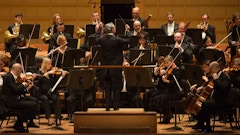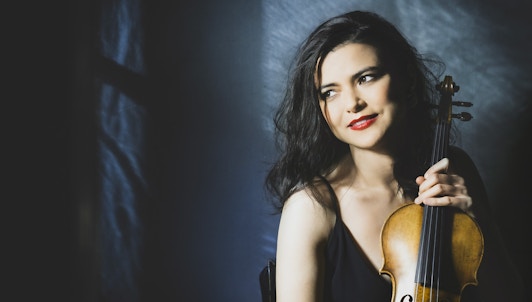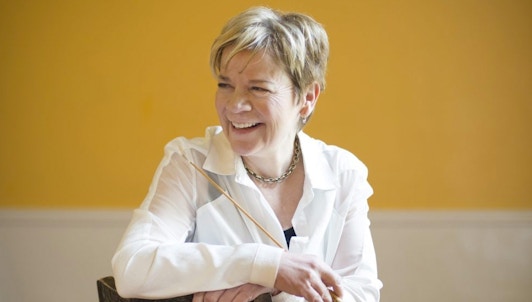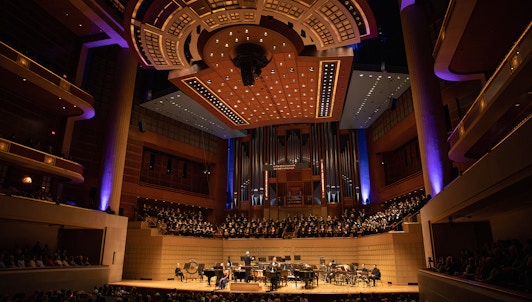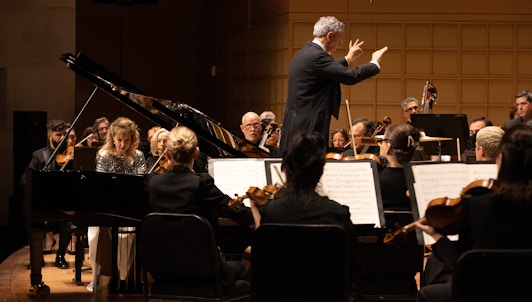Guided by internationally renowned Music Director Fabio Luisi, the Dallas Symphony Orchestra delivers uplifting, entertaining musical experiences and innovative, enriching educational opportunities—both within the inspiring Morton H. Meyerson Symphony Center and across the community.
The largest performing arts organization in the southwest United States, the Dallas Symphony Orchestra presents distinctive classical programs, inventive pops concerts and innovative multimedia events to inspire the broadest possible audience. To date, the orchestra has been served as Music Director by Antal Doráti (1945-48), Walter Hendl (1949-58), Sir Georg Solti (1961-62), Anshel Brusilow (1970-73), Max Rudolf (1973-74), Eduardo Mata (1977-93), Andrew Litton (1994-2006), Jaap van Zweden (2008-18) and Fabio Luisi, who inaugurated his tenure in September 2020.
The Dallas Symphony Orchestra traces its origins to a concert given by a group of 40 musicians conducted by Hans Kreissig in 1900. Born in Germany, Kreissig studied composition and conducting with Arthur Sullivan in London and served as accompanist to the English cornet player Jules Levy. He left for the States in 1883 as part of a touring opera company, and settled in Dallas one year later, where he made a living teaching piano and organ as well as directing church choirs. This was a period of huge growth for the city, which profited from being a railroad hub for transportation from east to west. From a small agricultural community, the city grew in numbers and financial standing, bringing with it a more affluent population and an interest in the arts.
The orchestra, like the city, evolved in both size and stature until it was in a position to appoint the eminent Hungarian conductor and composer Antal Doráti as Music Director in 1945. Doráti transformed the ensemble into a fully professional orchestra that won national attention through a series of RCA recordings, expanded repertoire, more concerts and several national network radio broadcasts. It was under Doráti that the Dallas Symphony recorded Liszt’s First Piano Concerto with Arthur Rubinstein and Bartók’s Second Violin Concerto with Yehudi Menuhin (both on RCA) and gave the North American premiere of Bartók’s Duke Bluebeard’s Castle in 1949.
When Mexican-born conductor Eduardo Mata was appointed Music Director in 1977, the orchestra embarked on its second major period of growth and success. Under Mata’s guidance the ensemble benefited from recording contracts with both RCA and Dorian, prominent national engagements in New York and Washington, and tours of Europe and South America. During his tenure the Dallas Symphony also saw the opening in 1989 of its permanent home, the Morton H. Meyerson Symphony Center. Designed by the award-winning team of I.M. Pei, Russell Johnson and Artec, this has since become an iconic architectural and acoustical national landmark.
Andrew Litton brought the Dallas Symphony unparalleled national and international exposure through recordings, telecasts, and tours. He made 26 compact discs with the DSO for five different labels. He led the orchestra on three European tours and four trips to Carnegie Hall. He hosted and conducted national telecasts on PBS and A&E. Mr. Litton conducted a wide repertoire, including several world premieres, but was especially noted for the music of Mahler, Shostakovich and Gershwin. He often appeared as a pianist on DSO concerts and in chamber music performances. He endeared himself to Dallasites through his outgoing personality and by establishing his residence here for the duration of his tenure, 1994 to 2006.
Jaap van Zweden took the helm as Music Director in 2008, and the orchestra continued to flourish under his dynamic leadership. Van Zweden led internationally acclaimed performances, championing the music of composers John Luther Adams, Philip Glass, Jennifer Higdon, Poul Rouders and Conrad Tao, among others. He conducted the world premiere performance and recording of Steven Stucky’s concert drama August 4, 1964, for which the composer was nominated for a Grammy Award, and recorded symphonies by Tchaikovsky (Nos. 4 and 5), Beethoven (Nos. 5 and 7), Mahler (Nos. 3 & 6) and Dvořák (No. 9) for the orchestra’s DSO Live label. Named Musical America’s Conductor of the Year 2012, Van Zweden completed his ten-year tenure at the DSO in May 2018.
The orchestra embarked on a bold new era in January 2018, when Kim Noltemy joined the Dallas Symphony Association (DSA) as Ross Perot President & CEO. Under her visionary leadership, the DSO has implemented numerous new initiatives. These include the Young Musicians education program, which offers free instruments and music lessons to all children in Southern Dallas, and the Women in Classical Music program. This has seen the establishment of an annual symposium and the appointments of Julia Wolfe and Angélica Negrón as Composers-in-Residence and of Gemma New as Principal Guest Conductor.
In June 2018, the Dallas Symphony Orchestra named Grammy Award-winning Italian conductor Fabio Luisi as its next Music Director. Over the next two years, Luisi developed a close rapport with the orchestra through a series of acclaimed performances, before assuming the Louise W. & Edmund J. Kahn Music Directorship in September 2020. During the global pandemic, the DSO pivoted quickly to expand its online presence and continue providing live music and service to the Dallas community. The historic season-opening concerts with which Luisi launched his tenure saw the DSO become the first major American orchestra to perform for an in-person audience in its own hall since the start of the COVID-19 shutdown, drawing widespread national praise. Today the Dallas Symphony Orchestra enjoys superlative artistic and executive leadership in one of the world’s foremost concert halls. Building on the past 120 years of outstanding music-making, Luisi, Noltemy and the orchestra continue to shape the 21st-century classical landscape, both in Dallas and beyond.
